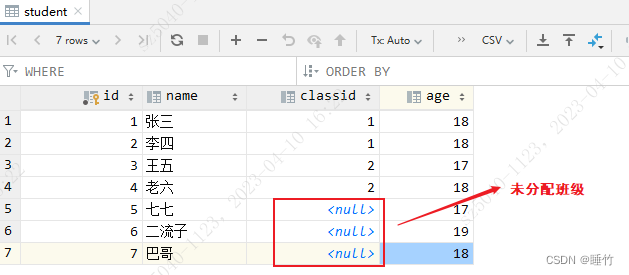MySQL多表查询内连接外连接详解(使用join、left join、right join和full join)
作者:睡竹
1、多表查询概览
1.1、分类
可以根据3个角度进行分类:
角度1:是否使用"="符号
- 等值接连:where条件中,表字段与表字段直接使用等于符号("=")进行判断
- 非等值连接:where条件中,表字段与表字段使用非"="符号,如:<=(小于等于)、>=(大于等于)、between and等等。
角度2:连接表的数量是否大于1
- 自连接:一张表直接的关联查询,自己表连接自己进行查询,如菜单表查子级
- 非自连接:多表关联查询
角度3:多表关联时,是否只查询有关联的数据
- 内连接:合并具有同一列的两个以上的表的行,结果集中不包含一个表与另一个表不匹配的行
- 外连接:合并具有同一列的两个以上的表的行,结果集中包含一个表与另一个表匹配的行之外,还包含了左表 或 右表不匹配的行
1.2、外连接的分类
- 左外连接(left outer join,可缩写为left join):两个表连接过程中,除了返回满足条件的行以外,还会返回左表中不满足条件的行,这种连接称为左连接
- 右外连接(right outer join,可缩写为right join):两个表连接过程中,除了返回满足条件的行以外,还会返回右表中不满足条件的行,这种连接称为右连接
- 全连接(full outer join,可缩写为full join):又称为"满外连接",两个表连接过程中,返回两表直接的所有数据,这种连接称为全连接
1.3、常用的SQL语法标准
- SQL92:1992发布的是数据库的一个ANSI/ISO标准(偶尔使用)
- SQL99:1999发布的是数据库的一个ANSI/ISO标准(现在开发中主流标准)
- ANSI:美国国家标准学会
- ISO:国际标准化组织
2、内外联接案例
2.1、初始化表
<1>学生表:student
create table if not exists taobao.student ( id int auto_increment primary key, name varchar(50) null, classid int null, age int null ) comment '学生表'; INSERT INTO student (id, name, classid, age) VALUES (1, '张三', 1, 18); INSERT INTO student (id, name, classid, age) VALUES (2, '李四', 1, 18); INSERT INTO student (id, name, classid, age) VALUES (3, '王五', 2, 17); INSERT INTO student (id, name, classid, age) VALUES (4, '老六', 2, 18); INSERT INTO student (id, name, classid, age) VALUES (5, '七七', null, 17); INSERT INTO student (id, name, classid, age) VALUES (6, '二流子', null, 19); INSERT INTO student (id, name, classid, age) VALUES (7, '巴哥', null, 18);
- 数据如图所示:

<2>班级表:classinfo
create table if not exists taobao.classinfo
(
classid int auto_increment primary key,
name varchar(100) null
)
comment '班级表';
INSERT INTO classinfo (name) VALUES ('高一1班');
INSERT INTO classinfo (name) VALUES ('高一2班');
INSERT INTO classinfo (name) VALUES ('高一3班');2.2、内连接
需求:查询已分配的学生信息,如:学生基本信息,所在班级名称
<1>SQL92内连接写法:
select
t1.id -- 学生ID
,t1.name -- 学生姓名
,t1.age -- 学生年龄
,t2.name -- 班级名称
from student t1,classinfo t2
where t1.classid=t2.classid<2>SQL99内连接写法:
select
t1.id -- 学生ID
,t1.name -- 学生姓名
,t1.age -- 学生年龄
,t2.name -- 班级名称
from student t1
join classinfo t2
on t1.classid=t2.classid结果:

2.3、外连接案例
需求:查询所有的学生信息,并查出学生所对应的班级名称
【注意:多表查询时,当查询一个表所有数据,该查询语句一定是外连接】
<1>SQL92外连接写法:
注意:
- 这种写法MySQL不支持,但在Oracle中支持
在不需要查询表中所有数据的那张表后,添加”(+)”,表示外连接(理解为这个表只是附加的)
select
t1.id -- 学生ID
,t1.name -- 学生姓名
,t1.age -- 学生年龄
,t2.name -- 班级名称
from student t1,classinfo t2
where t1.classid=t2.classid<strong>(+)</strong><2>SQL99外连接写法:
左连接写法:
select
t1.id -- 学生ID
,t1.name -- 学生姓名
,t1.age -- 学生年龄
,t2.name -- 班级名称
from student t1
left join classinfo t2 --注意:left join是缩写,也可以写为:left outer join
on t1.classid=t2.classid右连接写法:
select
t2.id -- 学生ID
,t2.name -- 学生姓名
,t2.age -- 学生年龄
,t1.name -- 班级名称
from classinfo t1
right join student t2
on t1.classid=t2.classid结果:

2.4、全连接案例
需求:查询学生表中的所有信息,并关联班级表信息及显示未关联的班级表信息
- 在SQL92中,并不直接支持全连接语法
SQL99全连接写法(Oracle):
关键字:full join ... on ... 或者 full outer join ... on ...
注意:MySQL不支持全连接,但是Oracle支持
select
t1.id -- 学生ID
,t1.name -- 学生姓名
,t1.age -- 学生年龄
,t2.name -- 班级名称
from student t1
full join classinfo t2
on t1.classid=t2.classidMySQL实现全连接,需要使用关键字"union"或者"union all"
2.5、union和union all
union:联合、合并的意思
union:对两个查询的结果集,进行合并操作,会对重复的数据进行去重,同时进行默认规则(主键升序)的排序(因此效率比较低)。
union all:对两个查询的结果集,进行合并操作,不对数据进行去重,也不进行排序,直接把两个结果进行合并(效率高)。
例如:我们把学生表查询两次,并使用union或union all进行合并
<1>union 语句
select * from student union -- 会进行去重操作 select * from student
结果:

<2>union all 语句
select * from student union all -- 不去重 select * from student
结果:

注意:
- union和union all使用时,select下的字段数量必须一致,否则会报错
2.6、实现MySQL全连接
需求:查询学生表中的所有信息,并关联班级表信息及显示未关联的班级表信息
实现方式有多种,这里我使用:
- 首先查询出学生表所有信息并显示对应的班级表信息
- 其次查询班级表中,classid不在学生表中的数据
- 把上述结果使用union all合并
代码如下:
select
t1.id -- 学生ID
,t1.name -- 学生姓名
,t1.age -- 学生年龄
,t2.name -- 班级名称
from student t1
left join classinfo t2 -- 注意:left join是缩写,也可以写为:left outer join
on t1.classid=t2.classid
union all
select
null -- null:这里设置为null,只是为了与上一个select的结果行字段(数量)进行匹配,以下2个null作用一样
,null
,null
,t1.name
from classinfo t1
where t1.classid not in (
select
distinct classid -- distinct表示去重
from student t2 where t2.classid is not null
)结果:

2.7、内外连接面试基础

上述图对应7种多表查询,是面试及实际开发中,必会的操作,这里就不多言了
- A:看作是学生表
- B:看作是班级表
注意:当关联表的数量超过3个时,禁止使用join,因为一个join相当于一个for,性能会很差
2.8、SQL99多表查询新特性
<1>natural join
- 自然连接:就是等值(内)连接,会自动查询两张连接表中所有相同的字段,然后进行等值连接
如:上面的内连接SQL为:
select
t1.id -- 学生ID
,t1.name -- 学生姓名
,t1.age -- 学生年龄
,t2.name -- 班级名称
from student t1
join classinfo t2
on t1.classid=t2.classid使用natural join进行改造,如下:
select
t1.id -- 学生ID
,t1.name -- 学生姓名
,t1.age -- 学生年龄
,t2.name -- 班级名称
from student t1
natural join classinfo t2 --自然连接结果:

查询到了0条数据,这是因为:
- natural join 关联多张表时,会自动根据表中相同的字段名称去匹配
- 上述student表中classid(班级编号)、name(学生姓名)与classinfo表中的 classid(班级编号)、name(班级名称)是一样的字段,而班级名称不可能与学生姓名相等,所以查询不到数据
也就是上述的自然连接,转义为内连接的SQL为:
select
t1.id -- 学生ID
,t1.name -- 学生姓名
,t1.age -- 学生年龄
,t2.name -- 班级名称
from student t1
join classinfo t2
on t1.classid=t2.classid
and t1.name = t2.name -- 这个条件也被自然连接附带上了因此,使用natural join的前提条件就是:
- 多表关联时,关联字段名称必须相同
- 不进行关联的字段名称必须不相同
综上:在实际开发中,我们应当避免使用natural join,造成表与表之间的耦合较高
<2>using
等值条件的一种优化写法
语法:
- using(多表关联的字段名称)
前提:
- 多表关联时,关联字段的名称必须相同
- 注意:这种写法公司一般不给使用,当某个字段改名时,很难定位错误
如:上面的内连接SQL为:
select
t1.id -- 学生ID
,t1.name -- 学生姓名
,t1.age -- 学生年龄
,t2.name -- 班级名称
from student t1
join classinfo t2
on t1.classid=t2.classid使用using:
select
t1.id -- 学生ID
,t1.name -- 学生姓名
,t1.age -- 学生年龄
,t2.name -- 班级名称
from student t1
join classinfo t2
using(classid)结果:

什么是外连接,和内连接的区别是什么?
内连接:假设A和B表进行连接,使用内连接的话,凡是A表和B表能够匹配上的记录查询出来,这就是内连接。AB两张表没有主副之分,两张表是平等的。
外连接:假设A和B表进行连接,使用外连接的话,AB两张表中有一张表是主表,一张表是副表。主要查询主表中的数据,捎带查询副表。当副表中的数据没有和主表中的数据匹配上,副表自动模拟出null与之匹配。
三张表的连接查询
案例:找出每一个员工的部门名称以及工资等级
......
A
join
B
join
C
on
......
表示:A表和B表先进行表连接,连接之后A表继续和C表进行连接。
总结
到此这篇关于MySQL多表查询内连接外连接的文章就介绍到这了,更多相关MySQL多表查询内连接外连接内容请搜索脚本之家以前的文章或继续浏览下面的相关文章希望大家以后多多支持脚本之家!

